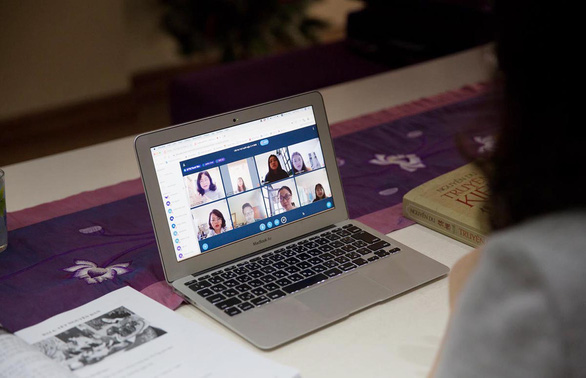
An online teaching and learning session at the University of Social Sciences and Humanities (Vietnam National University, Hanoi) - Photo: NV
"I was really stressed out in the beginning when teaching online; the workload was much heavier," "Teaching online is very troublesome, the only advantage is that you don't have to choose clothes to wear to class," "It's a nightmare"...
That was the sentiment of many university professors in the early stages of online teaching, when the COVID-19 pandemic forced the education sector to undergo rapid digital transformation. Now, however, as the pandemic is gradually being brought under control, the situation is different...
Reluctantly
Digital transformation was already part of the plans of many universities, but it was only when the COVID-19 pandemic occurred that online training was truly implemented on a large scale.
Dr. Tran Ngoc Hieu, from the Faculty of Literature at Hanoi Pedagogical University, admitted to experiencing severe stress in the initial stages: "The university implemented online teaching very early, before the 17th case of COVID-19 was reported. Most lecturers in the Faculty of Literature reluctantly attended the training, thinking it was just a temporary solution. No one thought online teaching would last until the end of the semester. Personally, I was very stressed because I had to adapt to different software and figure out how to make the lectures engaging and not boring."
Hanoi National University had to provide psychological support materials for both lecturers and students, highlighting the severity of this period. Dr. Truong Thi Bich Hanh, a lecturer in the History Department of the University of Social Sciences and Humanities (Hanoi National University), said: "In the first few weeks, both teachers and students were struggling because they were not yet accustomed to the new teaching and learning methods. In addition, the internet connection was unstable, and learning materials were lacking, so both teachers and students were under pressure. Furthermore, teaching social science subjects while only seeing students through a screen made it very difficult to know if students understood the lesson, so lecturers had to assign homework constantly."
Despite having experience in online teaching and learning, Dr. Ngo Bich Ngoc - lecturer in the PR, Advertising and Branding Program at Middlesex University (UK), Academy of Journalism and Communication - said that in the first few weeks she had to spend a lot of time supporting students. Both teacher and students had to use all kinds of software and applications, a kind of "Eastern and Western medicine combination," to overcome technical problems.
Opportunities in challenges
At the management level, university leaders feel that COVID-19 has brought a positive aspect because it has accelerated the process of online training from a planned phase to a reality.
Professor Hoang Anh Tuan, Vice Rector of the University of Social Sciences and Humanities (Hanoi), said: "The university implemented online teaching on a voluntary basis for both teachers and students, without forcing or pressuring lecturers to rush the process. Initially, when we opened the training course, we thought only 30 teachers would participate, but in the first week, 150 people joined. To date, there are up to 350 lecturers participating (equivalent to 95% of the university's lecturers)."
Dr. Tran Ngoc Hieu admitted that he was initially not enthusiastic about online training, but after teaching for a while, he realized the advantages of this method. "When I gave tests, I realized that many students in the class were very quiet, but when they responded to the teacher in writing, they did very well. Meanwhile, those who were very active in class discussions ended up answering incorrectly."
According to Dr. Truong Bich Hanh, her school had previously instructed lecturers to create their own websites to upload materials and conduct online tests, but few teachers paid attention: "After teaching online, I realized there are so many applications that support teaching. For example, I can set deadlines for students to submit assignments. The assignments are graded by computer very accurately, fairly, and transparently. I will definitely take advantage of those features after this period."
After the period of online teaching, universities were surprised to find that teachers and students, who had initially complained and shown little enthusiasm, now expressed a desire to continue using online training methods. According to a survey by the University of Social Sciences and Humanities (Hanoi), 75% of teachers want to continue teaching online, and will dedicate about 1-2 weeks to in-person lectures at the end of the semester to review and consolidate knowledge for students.
"Previously, universities planned for online training to account for 20%, but after this period, I think universities will tend to increase the percentage of hours dedicated to online training," Professor Hoang Anh Tuan commented.
|
It's no longer a temporary solution. According to Master Dinh Ngoc Son, deputy head of the Broadcasting and Television Department at the Academy of Journalism and Communication, online training is not a temporary solution for Vietnamese universities, but rather a method that runs parallel to traditional training. "Online training has made lecturers, students, and even parents realize the importance of technology in education. Teachers will also have to be more aware of improving the quality of their lectures. Students who choose this training method will also be more proactive and self-motivated in their learning," Mr. Son said. |
According to Tuoi Tre Online
Author:Ngoc Diep
Newer news
Older news